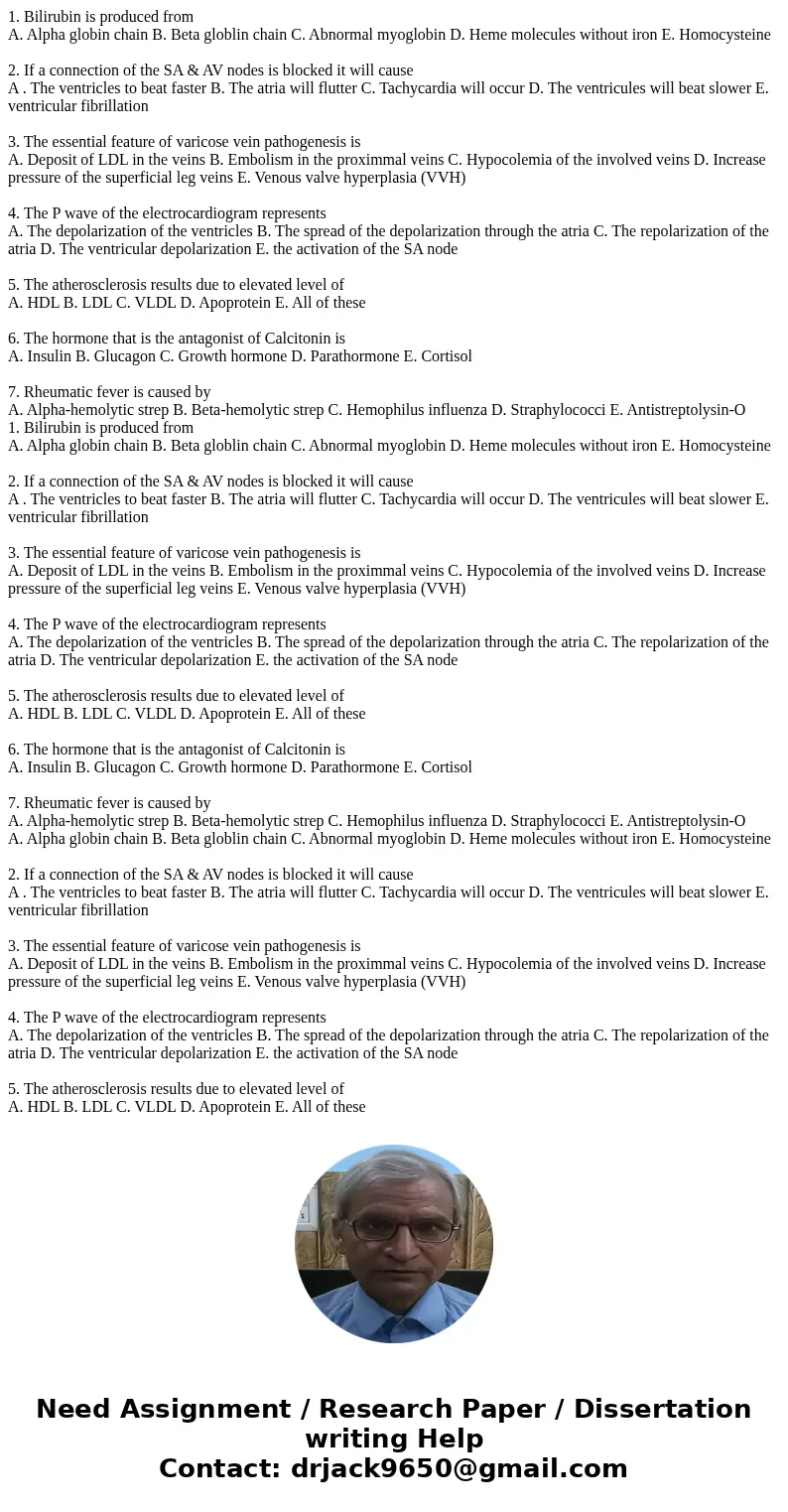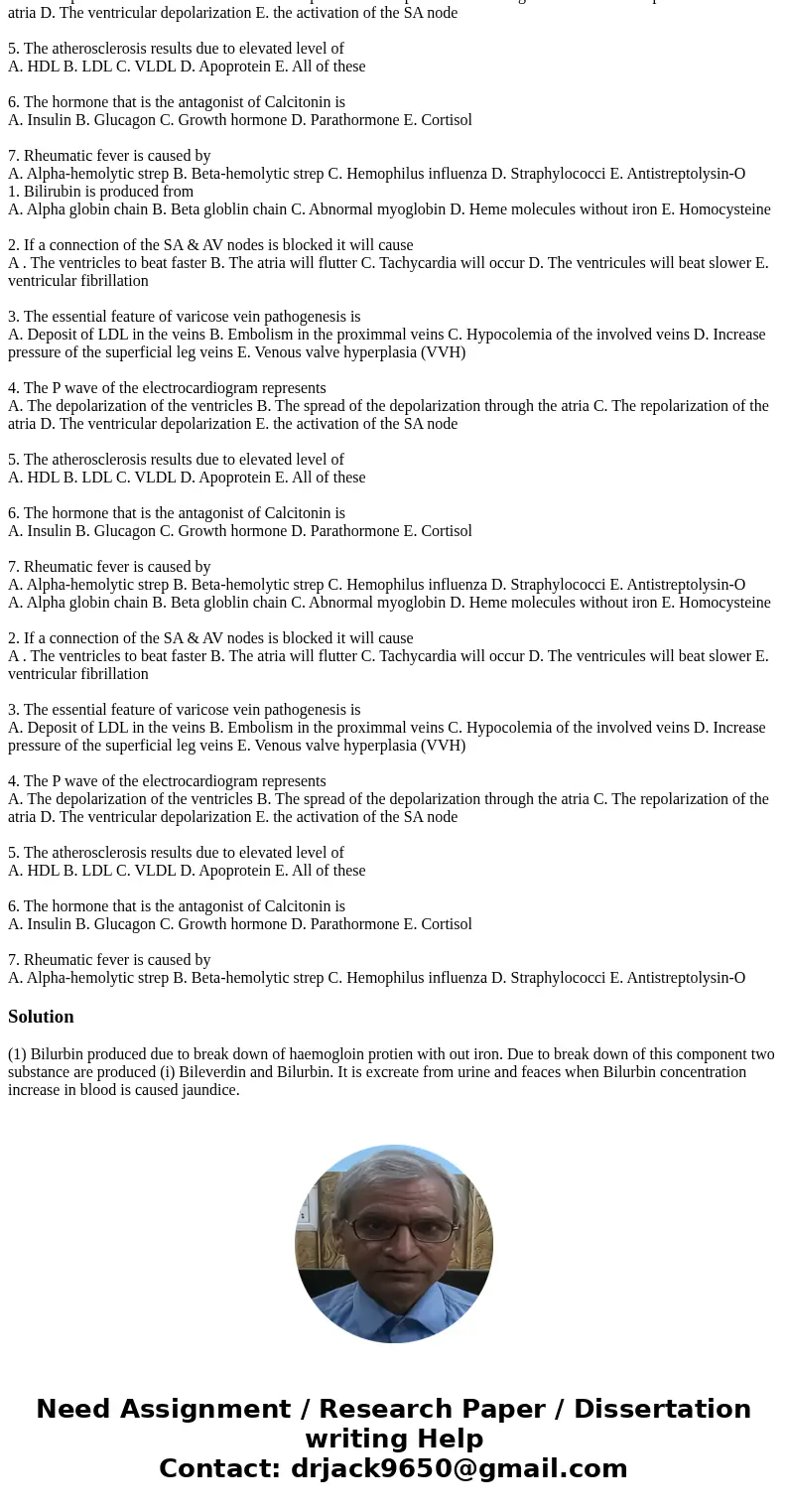1 Bilirubin is produced from A Alpha globin chain B Beta glo
1. Bilirubin is produced from
A. Alpha globin chain B. Beta globlin chain C. Abnormal myoglobin D. Heme molecules without iron E. Homocysteine
2. If a connection of the SA & AV nodes is blocked it will cause
A . The ventricles to beat faster B. The atria will flutter C. Tachycardia will occur D. The ventricules will beat slower E. ventricular fibrillation
3. The essential feature of varicose vein pathogenesis is
A. Deposit of LDL in the veins B. Embolism in the proximmal veins C. Hypocolemia of the involved veins D. Increase pressure of the superficial leg veins E. Venous valve hyperplasia (VVH)
4. The P wave of the electrocardiogram represents
A. The depolarization of the ventricles B. The spread of the depolarization through the atria C. The repolarization of the atria D. The ventricular depolarization E. the activation of the SA node
5. The atherosclerosis results due to elevated level of
A. HDL B. LDL C. VLDL D. Apoprotein E. All of these
6. The hormone that is the antagonist of Calcitonin is
A. Insulin B. Glucagon C. Growth hormone D. Parathormone E. Cortisol
7. Rheumatic fever is caused by
A. Alpha-hemolytic strep B. Beta-hemolytic strep C. Hemophilus influenza D. Straphylococci E. Antistreptolysin-O
1. Bilirubin is produced from
A. Alpha globin chain B. Beta globlin chain C. Abnormal myoglobin D. Heme molecules without iron E. Homocysteine
2. If a connection of the SA & AV nodes is blocked it will cause
A . The ventricles to beat faster B. The atria will flutter C. Tachycardia will occur D. The ventricules will beat slower E. ventricular fibrillation
3. The essential feature of varicose vein pathogenesis is
A. Deposit of LDL in the veins B. Embolism in the proximmal veins C. Hypocolemia of the involved veins D. Increase pressure of the superficial leg veins E. Venous valve hyperplasia (VVH)
4. The P wave of the electrocardiogram represents
A. The depolarization of the ventricles B. The spread of the depolarization through the atria C. The repolarization of the atria D. The ventricular depolarization E. the activation of the SA node
5. The atherosclerosis results due to elevated level of
A. HDL B. LDL C. VLDL D. Apoprotein E. All of these
6. The hormone that is the antagonist of Calcitonin is
A. Insulin B. Glucagon C. Growth hormone D. Parathormone E. Cortisol
7. Rheumatic fever is caused by
A. Alpha-hemolytic strep B. Beta-hemolytic strep C. Hemophilus influenza D. Straphylococci E. Antistreptolysin-O
A. Alpha globin chain B. Beta globlin chain C. Abnormal myoglobin D. Heme molecules without iron E. Homocysteine
2. If a connection of the SA & AV nodes is blocked it will cause
A . The ventricles to beat faster B. The atria will flutter C. Tachycardia will occur D. The ventricules will beat slower E. ventricular fibrillation
3. The essential feature of varicose vein pathogenesis is
A. Deposit of LDL in the veins B. Embolism in the proximmal veins C. Hypocolemia of the involved veins D. Increase pressure of the superficial leg veins E. Venous valve hyperplasia (VVH)
4. The P wave of the electrocardiogram represents
A. The depolarization of the ventricles B. The spread of the depolarization through the atria C. The repolarization of the atria D. The ventricular depolarization E. the activation of the SA node
5. The atherosclerosis results due to elevated level of
A. HDL B. LDL C. VLDL D. Apoprotein E. All of these
6. The hormone that is the antagonist of Calcitonin is
A. Insulin B. Glucagon C. Growth hormone D. Parathormone E. Cortisol
7. Rheumatic fever is caused by
A. Alpha-hemolytic strep B. Beta-hemolytic strep C. Hemophilus influenza D. Straphylococci E. Antistreptolysin-O
Solution
(1) Bilurbin produced due to break down of haemogloin protien with out iron. Due to break down of this component two substance are produced (i) Bileverdin and Bilurbin. It is excreate from urine and feaces when Bilurbin concentration increase in blood is caused jaundice.


 Homework Sourse
Homework Sourse